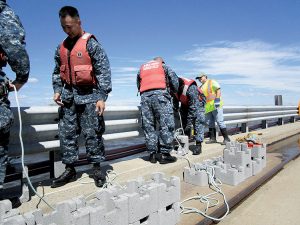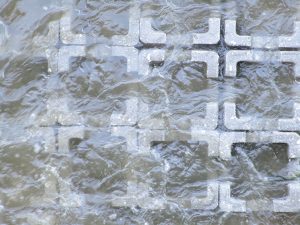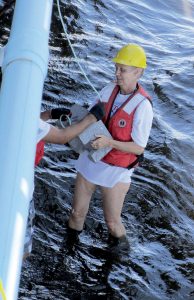Ecologists Hope To Bring Back Reefs
Story and photos by Joseph Sapia

N.W.S. EARLE – A short way out on the 2.9-mile pier of Naval Weapons Station Earle were several people, some on the pier itself, some standing in water as shallow as inches in the low tide.
Laid out on the pier were scores of 12-inch by 12-inch by 8-inch blocks that looked like children’s Legos, the inter-connecting construction toy. The New York-New Jersey Baykeeper, the Keyport-based group running the project, called them “oyster castles.”
A team of 20 sailors, Navy civilians, volunteers and Baykeeper employees worked together. Some lowered the castles over the pier’s west side, others set them on the bay’s bottom.
“They’re concrete structures that you can stack like Legos,” said Debbie Mans, the Baykeeper’s executive director. “We’re building an oyster reef we hope can grow.”
The idea of this “urban living shoreline” being put in place Aug. 17 was twofold: to seed local waters with eastern oyster juveniles and protect the shoreline from erosion, at the point where Ware’s Creek empties into the bay.
“What we’re putting in here is a long shoreline breakwater,” said Meredith Comi, the Baykeeper’s oyster restoration program director. “These are being used at different coastlines to fortify the coast.
“This is the first living shoreline on Raritan Bay (on the) Jersey side using oyster castles,” Comi said. “Think of this as our version of a coral reef.”
Working with the Navy, which has an almost-half-mile security zone around the pier, gives added protection to the reef – from such things as vandalism to the reef itself and poaching of oysters in these waters which the state has closed to shellfishing because of pollution.
So, the project is not to produce oysters for human consumption, but, according to Comi, for things such as shoreline stabilization in an area where the natural substrate has been ruined by urbanization, creating a more sound marine habitat and having oysters filter the water. An adult oyster can filter 50 gallons of water a day as it passes through it.
“We expect the living shoreline to provide data to tackle the impending threats of climate change and shoreline erosion,” Mans said. “The project will determine if a living shoreline can stabilize the mouth of Ware Creek, protect the surrounding environment, improve water quality and create aquatic habitat.”
Capt. Jay Steingold, Earle’s commander, said, “Our partnership is an example of the naval station’s efforts to combat the effects of climate change to our nation’s security and military infrastructure.
“Through this partnership, we seek to employ Mother Nature’s protective systems, like oyster reefs, to buttress the ever-changing shoreline at the Navy pier complex, while also enhancing the resiliency of a public storm evacuation route and improving water quality,” he said.

On this day, about 137 blocks, seeded with juvenile oysters that are each about 1 millimeter long, were placed in the bay. This totaled about 25,000 juveniles of the eastern oyster, “Crassostrea virginica.” If successful, they would grow to adult size, about 1-1/4 inches to 2-3/4 inches, in a year or so.
Over the next year, 1,000 castles will be put in place in the approximately 1-acre area, Comi said. The reef will rise about 3 feet off the bay bottom in waters that are 3 to 4 feet at low tide.
Native oysters disappeared from the area 75 to 100 years ago, Mans said.
The Baykeeper and Navy have been working together since 2010. At that time, the state Department of Environmental Protection banned shellfish research, restoration and education in public waters that were contaminated. So, the Baykeeper had to look for other waters – and Earle fit the bill.
The Baykeeper was “looking for a secure place to continue research where there wasn’t a risk of poaching,” said Bill Addison, an Earle spokesman.
Since, the Baykeeper has been doing various work at Earle. For example, between two pier trestles, the Baykeeper has created oyster habitat in a quarter-acre of water using two types of structures: masonry balls and mesh.
“There’s a few hundred thousand oysters there,” Mans said. “We’re monitoring the structures to see which one is best in Raritan Bay. It’s a dynamic (eco)system. Some might work better.”
Between the two pier trestles, the Baykeeper has a state permit to use 11 acres, but is using only the quarter acre at this time because the project is being worked in phases.

“Our pier facility seemed a natural fit for their research as the waters surrounding Naval Weapons Station Earle’s pier complex are restricted and they are patrolled by armed Navy security personnel,” Addison said.
“The latest iteration of their research will be more directly beneficial to the Navy facility as a natural living reef will bolster the Naval station’s storm resiliency and will help protect our valuable pier and shore infrastructure against potential storm damage and, of course, helps to clean the water our sailors and ships operate in every day,” Addison said.
“These shellfish were once an important part of both the bay’s ecosystem and local economy and could play an important role in the ecological restoration of the Hudson-Raritan Estuary,” Addison said.
“We have no reason they won’t do well, here,” Comi said.














